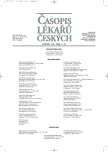-
Medical journals
- Career
Alternating Hemiplegia of Childhood (AHC)
Authors: S. Nevšímalová; M. Havlová; A. Tauberová; I. Příhodová
Authors‘ workplace: Neurologická klinika 1. LF UK a VFN, Praha
Published in: Čas. Lék. čes. 2005; 144: 692-696
Category: Original Article
Overview
Background.
Alternating hemiplegia of childhood (AHC) is a rare neurological disease of unknown aetiology characterized by recurrent paroxysmal attacks of side - alternating hemiplegias of variable duration associated withother paroxysmal dysfunctions. Paroxysmal attacks start in infants but neurological deficits become progressive with the age.Methods and Results.
During the last 20 years 8 patients (5 boys, 3 girls) with AHC were followed. Mean age at the time of diagnosis was 2.75 years, age range 2–5 years; mean follow up period 13.9 years (range 1 month-20 years) The diagnosis was based on clinical history and neurological findings, completed by neurophysiological and neuroimaging methods (SPECT, PET), and results of psychological and biochemical findings. Paroxysmal phenomena (occulo-motor, tonic, choreo-athetotic, autonomic) appearing at the age of 4.1±2.2 months and followed by repeated attacks of hemiplegia (age onset 16.3±13.0 months) were the first symptoms. Progressive neurological impairment covering spasticity, dyskinetic syndrome, cerebellar ataxia and intellectual deficit was present in all cases, epileptic seizures in 7 out of 8 patients. On ictal SPECT/PET examination hypoperfusion/glucose hypometabolism were demonstrated above affected hemispheres including basal ganglia, both thalami and cerebellar hemispheres. Improvement of hemiparesis was illustrated by nocturnal videomonitoring.Conclusions.
AHC is a chronic disease with progressive neurological deficit. A flunarizine therapy has a favorable effect on frequency and severity of paroxysmal attacks, but does not prevent a progressive neurological impairment.Key words:
alternating hemiplegia, paroxysmal attacks, diagnosis, neuroimaging methods, video-polysomnography, long-term follow-up, prognosis, therapy.
Labels
Addictology Allergology and clinical immunology Angiology Audiology Clinical biochemistry Dermatology & STDs Paediatric gastroenterology Paediatric surgery Paediatric cardiology Paediatric neurology Paediatric ENT Paediatric psychiatry Paediatric rheumatology Diabetology Pharmacy Vascular surgery Pain management Dental Hygienist
Article was published inJournal of Czech Physicians

-
All articles in this issue
- Periodic Limb Movements in Sleep: Polysomnographic and Actigraphic Methods for Their Detection
- Alternating Hemiplegia of Childhood (AHC)
- Embolism of the Upper Mesenteric Artery
- Treatment of Juvenile Pemphigus Vulgaris with Intravenous Immunoglobulins
- Alcohol and Pregnancy
- How Many Pathological Gamblers is in the Czech Republic
- A Hitherto Unknown Priority of Jan Ev. Purkyně – Myocardial Sleeves of the Pulmonary Veins. Contribution to the Pathogenesis of Atrial Fibrillation
- Purkyně´s Concept of Neuron
- Future Possibilities of the Multiple Sclerosis Treatment
- Aging Eye – Its Specific Features and Diseases
- Lung Cancer Operability – History and Presence
- Intermittent Catheterization of Urinary Bladder – Indications, Technique, Complications
- Time Perception in Functional Imaging
- Heart Rate Variability During Sleep
- Journal of Czech Physicians
- Journal archive
- Current issue
- Online only
- About the journal
Most read in this issue- Heart Rate Variability During Sleep
- Alternating Hemiplegia of Childhood (AHC)
- Intermittent Catheterization of Urinary Bladder – Indications, Technique, Complications
- Alcohol and Pregnancy
Login#ADS_BOTTOM_SCRIPTS#Forgotten passwordEnter the email address that you registered with. We will send you instructions on how to set a new password.
- Career

